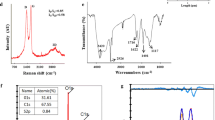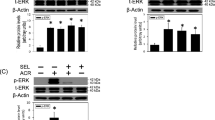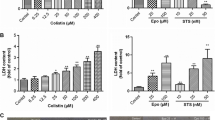Abstract
Clioquinol has been implicated as a causative agent for subacute myelo-optico-neuropathy (SMON) in humans, although the mechanism remains to be elucidated. In this study, we utilized astrocyte-derived cell line, KT-5 cells to explore its potential cytotoxicity on glial cells. KT-5 cells were exposed in vitro to a maximum of 50 μM clioquinol for up to 24 h. 3-[4,5-dimethylthiazol-2-yl]-2,5-diphenylte trazolium bromide (MTT) assay of the cells revealed that clioquinol induced significant cell damage and death. We also found that clioquinol caused accumulation of microtubule-associated protein light chain-3 (LC3)-II and sequestosome-1 (p62) in a dose- and time-dependent manner, suggesting the abnormality of autophagy–lysosome pathway. Consistent with these findings, an exposure of 20 μM clioquinol induced the accumulation of cellular autophagic vacuoles. Moreover, an exposure of 20 μM clioquinol provoked a statistically significant reduction of intracellular lysosomal acid hydrolases activities but no change in lysosomal pH. It also resulted in a significant decline of intracellular ATP levels, enhanced cellular levels of reactive oxygen species, and eventually cell death. This cell death at least did not appear to occur via apoptosis. 10 μM Chloroquine, lysosomal inhibitor, blocked the autophagic degradation and augmented clioquinol-cytotoxicity, whereas rapamycin, an inducer of autophagy, rescued clioquinol-induced cytotoxicity. Thus, our present results strongly suggest clioquinol acts as a potentially cytotoxic agent to glial cells. For future clinical application of clioquinol on the treatment of neurological and cancer disorders, we should take account of this type of cell death mechanism.





Similar content being viewed by others
Availability of data and material
The datasets generated for this study are available on request to the corresponding author.
Abbreviations
- SMON:
-
Subacute myelo-optico-neuropathy
- DMSO:
-
Dimethyl sulfoxide
- LC3:
-
Microtubule-associated protein light chain-3
- p62:
-
Sequestosome-1
- ROS:
-
Reactive oxygen species
- NAC:
-
N-Acetyl cysteine
- p-Akt:
-
Phosphorylated Akt kinase
- MTT:
-
3-(4,5-Di-methylthiazol-2-yl)-2,5-diphenyltetrazolium bromide
References
Andréasson M, Solders G, Björkvall CK, Machaczka M, Svenningsson P (2019) Polyneuropathy in Gaucher disease type 1 and 3—a descriptive case series. Sci Rep 9(1):15358. https://doi.org/10.1038/s41598-019-51976-2
Asakura K, Ueda A, Kawamura N, Ueda M, Mihara T, Mutoh T (2009) Clioquinol inhibits NGF-induced Trk autophosphorylation and neurite outgrowth in PC12 cells. Brain Res 1301:110–115
Aschner M (1998) Astrocytic functions and physiological reactions to injury: the potential to induce and/or exacerbate neuronal dysfunction—a forum position paper. Neurotoxicol 19:7–17 (discussion 37–8)
Benvenisti-Zarom L, Chen J, Regan RF (2005) The oxidative neurotoxicity of clioquinol. Neuropharmacol 49:687–694
Button RW, Roberts SL, Willis TL, Hanemann CO, Luo S (2017) Accumulation of autophagosomes confers cytotoxicity. J Biol Chem 292:13599–13614
Chen D et al (2007) Clioquinol, a therapeutic agent for Alzheimer’s disease, has proteasome-inhibitory, androgen receptor-suppressing, apoptosis-inducing, and antitumor activities in human prostate cancer cells and xenografts. Cancer Res 67:1636–1644
Cherny RA et al (2001) Treatment with a copper-zinc chelator markedly and rapidly inhibits beta-amyloid accumulation in Alzheimer’s disease transgenic mice. Neuron 30:665–676
Christensen KA, Myers JT, Swanson JA (2002) pH-dependent regulation of lysosomal calcium in macrophages. J cell sci 115:599–607
Cook KL, Shajahan AN, Clarke R (2011) Autophagy and endocrine resistance in breast cancer. Exp Rev Anticancer Therapy 11:1283–1294
Fukui T et al (2015) Histone deacetylase inhibitor attenuates neurotoxicity of clioquinol in PC12 cells. Toxicology 331:112–118
Hotchkiss RS, Strasser A, McDunn JE, Swanson PE (2009) Cell death. N Engl J Med 361:1570–1583
Katsuyama M, Iwata K, Ibi M, Matsuno K, Matsumoto M, Yabe-Nishimura C (2012) Clioquinol induces DNA double-strand breaks, activation of ATM, and subsequent activation of p53signaling. Toxicology 299:55–59
Kaur D et al (2003) Genetic or pharmacological iron chelation prevents MPTP-induced neurotoxicity in vivo: a novel therapy for Parkinson’s disease. Neuron 37:899–909
Kawamura K, Kuroda Y, Sogo M, Fujimoto M, Inui T, Mitsui T (2014) Superoxide dismutase as a target of clioquinol-induced neurotoxicity. Biochem Biophys Res Commun 452:181–185
Lu Y, Hao BX, Graeff R, Wong CW, Wu WT, Yue J (2013) Two pore channel 2 (TPC2) inhibits autophagosomal-lysosomal fusion by alkalinizing lysosomal pH. J Biol Chem 288:24247–24263
Martin-Pardillos A, Sosa C, Sorribas V (2013) Arsenic increases Pi-mediated vascular calcification and induces premature senescence in vascular smooth muscle cells. Toxicol Sci 131:641–653
MestreCitrinovitz AC, Strowitzki T, Germeyer A (2019) Decreased autophagy impairs decidualization of human endometrial stromal cells: a role for ATG proteins in endometrial physiology. Int J Mol Sci 20(12):3066. https://doi.org/10.3390/ijms20123066
Mutoh T, Senda Y, Sugimura K, Koike Y, Matsuoka Y, Sobue I, Naoi M (1988) Severe orthostatic hypotension in a female carrier of Fabry’s disease. Arch Neurol 45:244–253
Nakae K, Yamamoto S, Shigematsu I, Kono R (1973) Relation between subacute myelo-optic neuropathy (SMON) and clioquinol: nationwide survey. Lancet 1:171–173
Nakashima S et al (2003) Vacuolar H+-ATPase inhibitor induces apoptosis via lysosomal dysfunction in the human gastric cancer cell line MKN-1. J Biochem 134:359–364
Nguyen T, Hamby A, Massa SM (2005) Clioquinol down-regulates mutant huntingtin expression in vitro and mitigates pathology in a Huntington’s disease mouse model. Proc Natl Acad Sci USA 102:11840–11845
Niedzwiedz A, Jaworski Z, Tykalowski B, Smialek M (2014) Neutrophil and macrophage apoptosis in bronchoalveolar lavage fluid from healthy horses and horses with recurrent airway obstruction (RAO). BMC Vet Res 10:29
Park MH, Lee SJ, Byun HR, Kim Y, Oh YJ, Koh JY, Hwang JJ (2011) Clioquinol induces autophagy in cultured astrocytes and neurons by acting as a zinc ionophore. Neurobiol Dis 42:242–251
Tajima Y et al (2009) Use of a modified alpha-N-acetylgalactosaminidase in the development of enzyme replacement therapy for Fabry disease. Amer J Hum Genet 85:569–580
Tateishi J (2000) Subacute myelo-optico-neuropathy: clioquinol intoxication in humans and animals. Neuropathology 20(Suppl):S20-24
Trombetta ES, Ebersold M, Garrett W, Pypaert M, Mellman I (2003) Activation of lysosomal function during dendritic cell maturation. Science 299:1400–1403
Yamanaka K et al (2008) Astrocytes as determinants of disease progression in inherited amyotrophic lateral sclerosis. Nat Neurosci 11:251–253
Funding
The present work was partly supported by a Grant-in-Aid for the NEXT-Supported Program for the Strategic Research Foundation at Private Universities and Scientific Research (C) from the Ministry of Education, Culture, Sports, Science and Technology of Japan, as well as a Research Grant for Intractable Diseases from the Ministry of Health, Labor and Welfare of Japan to T Mutoh.
Author information
Authors and Affiliations
Contributions
YM performed the experiments, and analyzed the data, and wrote the initial version of the manuscript. KM and TM contributed to western blotting assays and the measurements of lysosomal hydrolase activity. SI contributed the measurement of intracellular ATP levels and MTT assays and intellectual contents. All of them contributed to the intellectual contents. HW contributed to the statistical analysis. TM contributed the conception, designed the study, supervision, and revised the manuscript. All authors read and approved the submission of the final manuscript.
Corresponding author
Ethics declarations
Conflict of interest
The authors declare that the research was conducted in the absence of any commercial or financial relationships that could be construed as a potential conflict of interest.
Additional information
Publisher's Note
Springer Nature remains neutral with regard to jurisdictional claims in published maps and institutional affiliations.
Rights and permissions
About this article
Cite this article
Mizutani, Y., Maeda, T., Murate, K. et al. Clioquinol kills astrocyte-derived KT-5 cells by the impairment of the autophagy–lysosome pathway. Arch Toxicol 95, 631–640 (2021). https://doi.org/10.1007/s00204-020-02943-8
Received:
Accepted:
Published:
Issue Date:
DOI: https://doi.org/10.1007/s00204-020-02943-8




